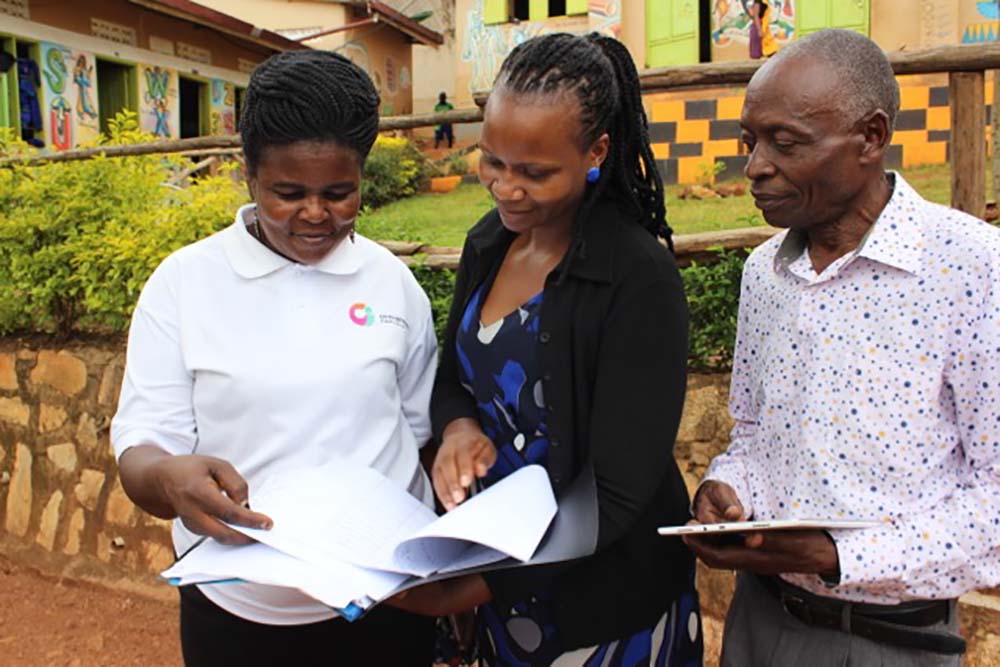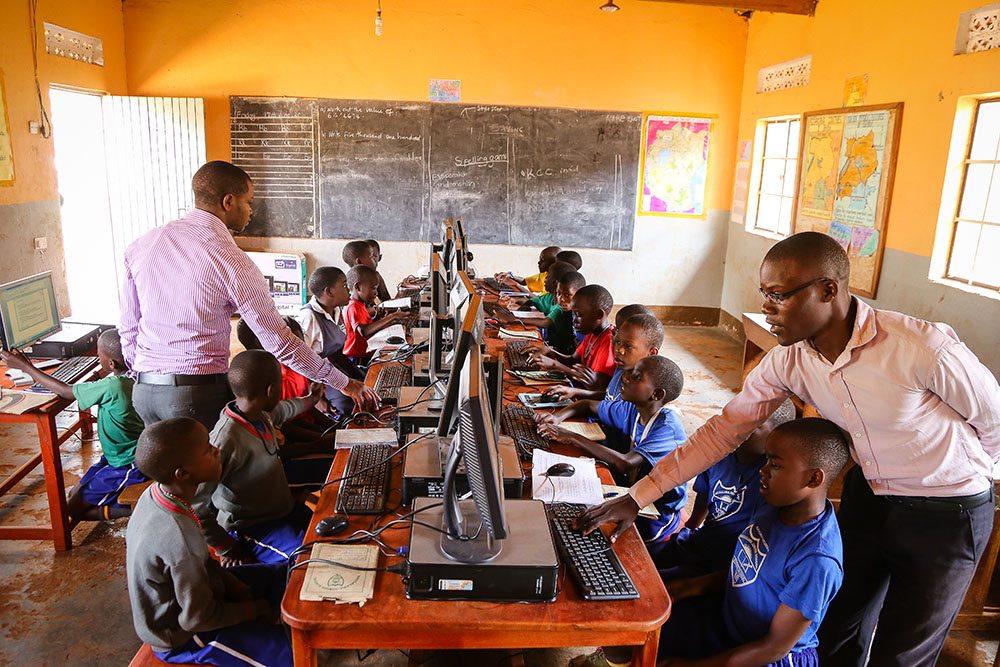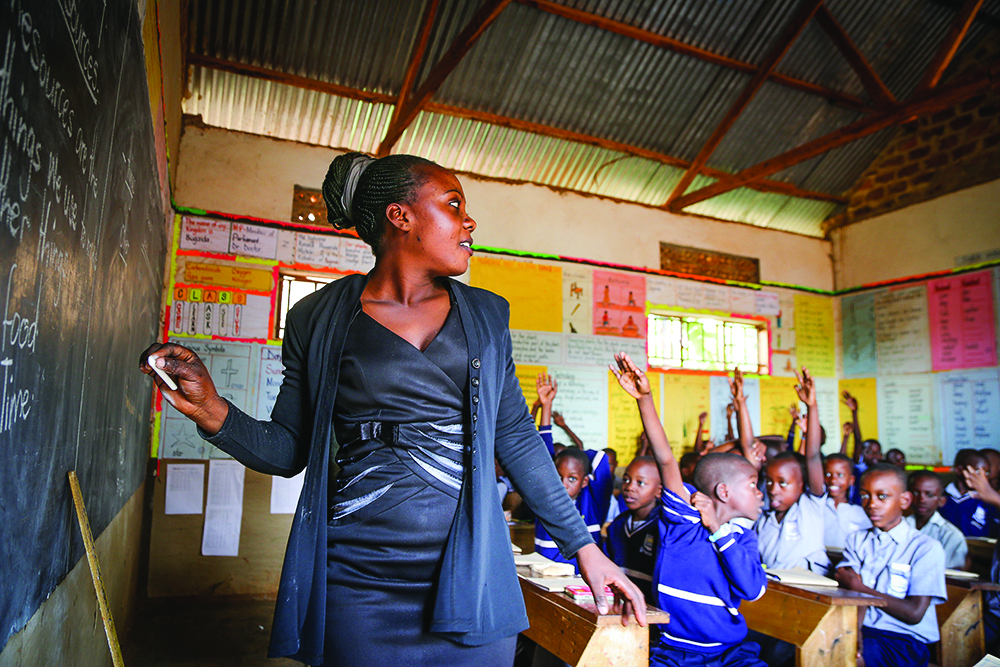Opportunity International Education Finance: Unlocking Quality Education for This Generation
Description
Established in 2008, Opportunity International’s Education Finance (EduFinance) initiative offers a systemic approach – blending local financing with quality improvement support for affordable private schools – that helps children living in poor communities go to school and stay in school, while improving the quality of education schools provide.To date, more than 3.2 million children in 20 developing countries have been reached through EduFinance, and more than 1,000 affordable private schools are currently participating in Opportunity’s quality improvement initiative that equips school leaders with data and locally-driven methods for improving school sustainability, teacher quality, and learning outcomes for students.
Instead of building schools, EduFinance builds the capacity of local communities to build and grow their own quality, affordable private schools.<br />
<br />
Challenge #1: Access to school – both in terms of distance and the financial capacity of low-income families to afford all the costs of education for their children, including uniforms, lunches and books – is a key challenge that keeps children from attending school, or causes them to drop out early. Opportunity EduFinance unlocks local capital for educators to build and grow schools in underserved communities, and for parents to cover the costs of education when household cashflow is tight. EduFinance works through local financial institutions, which are often wary of entering the commercial education finance sector. EduFinance provides technical assistance that builds the capacity of financial institutions and equips them with business intelligence tools, enabling them to launch or grow education loan portfolios, which often include Opportunity’s flagship financial products: School Improvement Loans and School Fee Loans. School Improvement Loans provide school leaders with capital to invest in the greatest needs of their school, such as new bathrooms, classrooms, and teachers. School Fee Loans help ease the pressure of up-front tuition costs for low-income parents, effectively spreading out the costs of their children’s education in more manageable increments to prevent dropouts or missed classes during times of economic uncertainty. <br />
<br />
Challenge #2: The quality of affordable private schools varies widely, given that these schools often operate as fragmented, small businesses – EduFinance establishes clusters of schools, which are small, self-led networks of local private school leaders and teachers who work together to spark collaboration, share best practices, and provide professional support. This bottom-up approach leverages the natural incentive of educators to be better at what they do and provides them with access to localized trainings and Opportunity’s Pathways to Excellence assessment tool. Pathways to Excellence measures a school’s quality across 42 domains, including learning environment, pupil achievement, teacher retention, and early childhood development, and the data from which used by school leaders to create a School Development Plan. In collaboration with a team of teachers, parents and community members, school leaders identify the domains within Pathways to improve upon, and create an action plan to implement effective, sustainable improvements over time.
-Financial institutions: EduFinance has a rapidly expanding pipeline of financial institution partners that are interested in launching or growing EduFinance products.
-Beneficiaries: EduFinance gathers feedback from school owners and educators via cluster meetings and surveys to identify the most valuable trainings and support.
-Donors: EduFinance is supported by donors including major foundations, corporations and private donors. When appropriate, educational experts within donor organizations offer guidance and support for EduFinance.
-Education organizations – EduFinance partners with organizations with expertise in topics such as early childhood development, curriculum development, and youth financial literacy.
EduFinance activities are concentrated on three core workstreams:
1. Scaling EduFinance Lending -- EduFinance operates locally through a network of partner financial institutions, each of which is identified and engaged by Opportunity’s EduFinance Technical Assistance Facility (ETAF) team. ETAF provides hands-on training and support to financial institutions that are hesitant to enter the commercial education finance sector due to lack of internal expertise and understanding around risk, margins, and regulations. With support from ETAF, financial institutions can capably invest in the internal processes, tools, and staff necessary to launch and manage education loan portfolios.
2. Improving Education Quality -- In select markets, Opportunity partners with financial institutions to launch Education Quality services in addition to loans to help school owners more effectively grow and improve their schools. With Education Quality, educators receive hands-on guidance through local Opportunity clusters, trainings, and tablet-based assessments designed to improve conditions for learning and strengthen schools’ financial sustainability long-term. Within each market, Opportunity recruits experienced local professionals, often former teachers or education administrators, to become Education Specialists who help form, train, and manage school clusters. Education Specialists work with the financial institution to identify school owners who are using School Improvement loans and travel to communities to invite those schools, as well as other nearby schools, to an Introductory Seminar to learn more about how to join or form a local school cluster. Through the cluster model, Opportunity is able to deliver targeted training and resources to educators, who also use cluster meetings to share ideas and best practices, such as how to effectively manage classroom behavior, or strategies for engaging parents in learning. Through clusters, school owners also learn how to self-assess their school’s quality using Opportunity’s Pathways to Excellence (P2E) guide. School owners also draft a School Development Plan utilizing a guidebook from Opportunity and the results of their P2E assessments.
3. Increase Learnings and Research – Opportunity continuously collects data and conducts research studies to assess outcomes and identify areas in which EduFinance can improve and enhance its operating model. EduFinance collects data through the following tools:
-EdPack – A business intelligence tool for EduFinance’s financial institution partners, who submit monthly reports to the EduFinance Operations team on the performance of education loan products. Using the data provided, the EdPack provides ongoing analyses of risk, sales trends, and other insights to improve product performance of education loans within each financial institution and support the long-term viability of education loan portfolios.
-Pathways to Excellence (P2E) Assessments – A measurement tool used to benchmark schools’ quality against 42 domains (including 12 early childhood domains). Data gathered include how well a school maintains a clean and safe environment conducive to learning; depth of staff and teacher engagement; quality of child-centered teaching practices; and how well a school engages with its surrounding community.
-School Development Plans – An annual planning document for schools to identify 2-5 P2E domains and develop next steps to make improvements within those domains.
Recent studies also demonstrate the real impact of Opportunity’s work:
Schools are Growing and Improving: Schools in Uganda served by Opportunity for at least three years have achieved, on average, 24% enrollment growth, 36% increase in teaching staff, and an increase in income of 63%. Additionally, 39% of schools used Opportunity loans to construct additional classrooms; 9% invested in WASH facilities—a proven method for keeping girls in school longer, and all students much healthier; 25% invested their loans in school vans, dormitory beds, and teacher salaries; 24% purchased land, built dorms or kitchens, purchased cooking stoves or added new technology, such as computers.
In Ghana, schools that received loans from Opportunity experienced on average 19% enrollment growth and 20% more teachers. The schools also achieved 23% higher marks on the government-advised Ghana Education System quality indicators, meaning the schools are providing students with a better quality education after receiving financing from Opportunity.
Students are Learning More, Especially Girls: In 2016, Opportunity conducted an independent evaluation to measure the impact of its services on schools in Uganda. Results demonstrate students at schools that benefited from a School Improvement Loan increased literacy by 17 words per minute over a control group; enrollment of girls in secondary school increased 17% against control schools.
The research also looked at the impact of Opportunity’s financial education on girls with encouraging results: 98.6% of girls reported increased confidence in financial planning and budgeting; 72.4% of girls have taken up social enterprise projects. Most of the girls have identified school and community challenges related to hygiene and sanitation, lack of balanced diet, and others; 92.8% began saving money formally and 89.6% of those keep a record on their savings cards.
More Teachers and Jobs are Added in Communities: Through a survey of 94 Opportunity-supported schools in Uganda, new jobs were created by School Improvement Loans in 80% of all schools surveyed, averaging 3.9 new full-time positions per school. One school added 19 new jobs as a result of the loan and the growth the school was able to achieve. Schools hired more teachers (averaging 2 new teachers per loan), as well as other support staff, including cleaners, food workers, nurses, and administrative staff. Additionally, 95% of the schools hired construction workers to complete improvements on their schools. School owners reported to have hired an average of 7.4 construction workers with their most recent loan, with the construction jobs lasting an average of 2.3 months.
Low-cost model – By partnering with existing financial institutions and establishing localized, self-managed clusters, Opportunity is leveraging existing resources in communities (local schools, educators, local financing) to improve educational outcomes, instead of building new schools or relying on expensive training and assessment tools.
Access to capital for schools – By working with financial institutions, Opportunity helps connect school leaders to much-needed capital to invest in school improvements, such as building new classrooms or bathrooms, or hiring more teachers, accelerating progress and impact.
Access to capital for parents – By working with financial institutions, Opportunity helps parents access the needed up-front financing to send their children to affordable private schools, which in turn helps increase attendance.
Key constraints:
EduQuality is a newer program – Early results indicate the model is effectively supporting schools in implementing improvements, but Opportunity will need more historical data to use a proof points, and to continue assessing and optimizing the program components.
Participation can be time-intensive – Educators who are over-taxed may not have the time or resources to participate in all program components, limiting the impact of the program.
Teacher turnover or transfers – An unavoidable risk will be investing resources in educators who may later leave or change jobs. Opportunity is focusing on developing cluster trainings and teacher-mentor initiatives that support the professional development of teachers, and support school leaders in cultivating good workplaces for teachers, with the ultimate goal of retaining and improving the quality of teachers in low-resourced communities.
Grant funding – EduFinance’s operations are largely dependent on donor funding, which is the primary constraint for the program’s growth. If more donor funding was available, Opportunity would be able to meet more of the existing demand for EduFinance services (from both financial institutions and from schools for Education Quality).
In 2007, Opportunity set out to design a localized, finance-based approach to combat one of the biggest challenges for parents living in poverty: giving their children the education they deserve. Opportunity knew, after decades of serving mothers and fathers living in developing communities, that this was one of their greatest desires, as well as one of their biggest regrets when they had to watch their children grow up without the opportunity to go to school. Parents all around the world, regardless of income level or nationality, know that a good education is their child’s greatest tool for success in life, yet millions of families live in regions where there are no nearby schools, or only poor quality schools, resulting in a global education gap that perpetuates poverty and inequality, generation after generation. <br />
From 2007 to 2012, Opportunity got to work on designing a program that empowers local parents and educators to make the changes they wish to see in their communities—such as schools that offer smaller class sizes and dormitories for rural students; schools with computers so children could learn in-demand skills; and schools with gender-separated bathrooms and trained teachers to help engage and encourage girls to stay in school. By driving these changes, parents can ensure their own children will gain a good education, even in some of the most challenging environments. <br />
After testing and refining the School Improvement Loan and School Fee Loan, Opportunity launched the products in select markets in Africa, quickly gaining traction with local communities. Since 2012, Opportunity’s EduFinance portfolio has continued to rapidly expand, and today more than $191 million has been loaned to parents and educators, impacting 3.2 million children. Additionally, after launching the Education Quality initiative in 2015, Opportunity has engaged more than 1,000 schools in clusters across six countries, and is quickly growing to new regions and countries in response to significant demand from financial institutions and affordable private schools.<br />
Opportunity’s work is far from done. Moving forward, Opportunity will continue its efforts to quickly expand EduFinance and Education Quality to new markets, opening up the possibilities for millions more children to gain access to a quality education. If the past five years have shown us that this work is possible, then our hope for the next five years is to show us that we can, as a global community, solve the education crisis within a generation.
https://www.newtimes.co.rw/lifestyle/local-school-wins-continental-qual…
https://www.investegate.co.uk/cgap/gnw/credit-suisse-partners-with-cgap…
https://www.webwire.com/ViewPressRel.asp?aId=232632
http://dailyguideafrica.com/opportunity-grants-scholarships-to-329-pupi…
https://www.graphic.com.gh/news/general-news/three-schools-win-awards-f…
http://www.switzer.com.au/the-experts/chikondi-mpokosa/helping-women-an…
SDGS & Targets
Deliverables & Timeline
Resources mobilized
Partnership Progress
| Name | Description |
|---|
Feedback
Action Network


Timeline
Entity
Region
- Africa
Geographical coverage
Photos



Website/More information
Countries

Contact Information
Simona Haiduc, Managing Director, Strategic Partnerships
